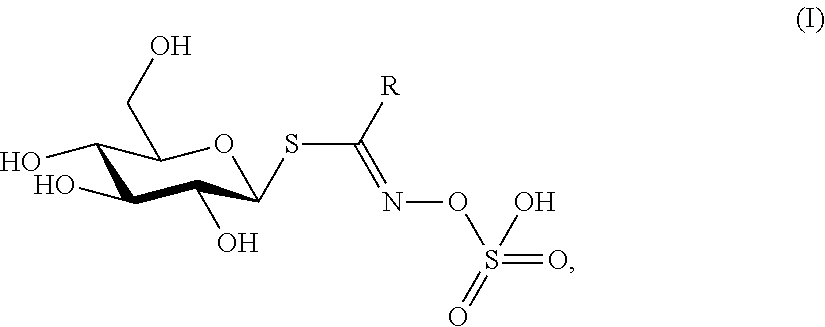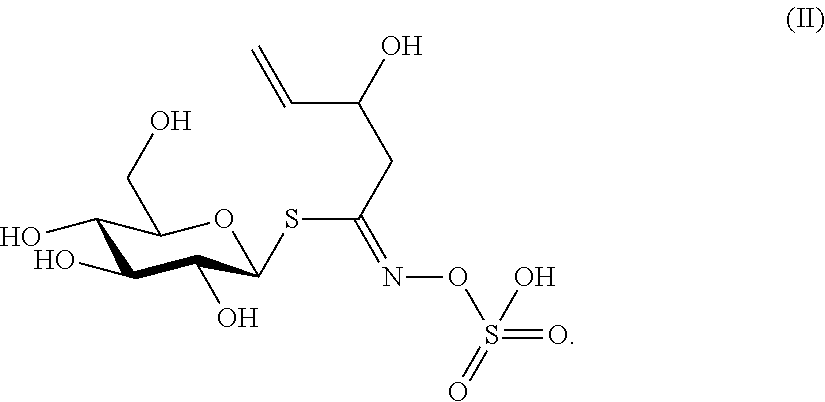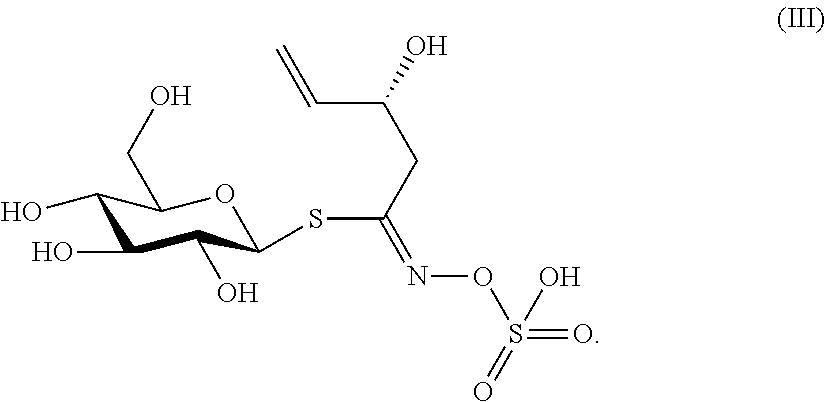Biopesticide compositions comprising water soluble polyols
a biopesticide and composition technology, applied in the field of liquid compositions, can solve the problems of affecting the efficacy of biopesticides, and affecting and thereby reducing the efficacy of biopesticides
- Summary
- Abstract
- Description
- Claims
- Application Information
AI Technical Summary
Benefits of technology
Problems solved by technology
Method used
Image
Examples
example 1
Preparation of a Liquid Biopesticide Formulation Comprising Propylene Glycol
[0122]Three dry myrosinase / sinigrin samples were prepared, each sample containing: 0.025 g milled Sinapis alba meal (containing active myrosinase), and 0.075 g of a particulate sinigrin concentrate (containing approximately 25% pure sinigrin). Two propylene glycol solutions were prepared as follows: a first solution containing (80% (v / v) propylene glycol (1,3 propane diol) / 20% (v / v) water), ascorbic acid (1 mM), MgCl2 (1 mM) and potassium phosphate buffer (pH 6.5); and a second solution containing 60% (v / v) propylene glycol 1,3 propane diol / 40% (v / v) water), ascorbic acid (1 mM), MgCl2 (1 mM) and potassium phosphate buffer (pH 6.5). A control was prepared containing 100% (v / v) water as the water, ascorbic acid, MgCl2 and potassium phosphate buffer (pH 6.5). The three myrosinase / sinigrin samples were mixed with 4 ml of the first and second propylene glycol solutions in a sealable glass vial (i.e. the (80% (v / ...
example 2
Preparation of a Liquid Biopesticide Formulation Comprising Glycerol
[0124]Three dry myrosinase / sinigrin samples were prepared, each sample containing: 0.025 g milled Sinapis alba meal (containing active myrosinase), and 0.075 g of a particulate sinigrin concentrate (containing approximately 25% pure sinigrin). Two polyethylene glycol solutions were prepared as follows: a first solution containing (80% (v / v) glycerol / 20% (v / v) water), ascorbic acid (1 mM), MgCl2 (1 mM) and potassium phosphate buffer (pH 6.5); and a second solution containing 60% (v / v) glycerol / 40% (v / v) water), ascorbic acid (1 mM), MgCl2 (1 mM) and potassium phosphate buffer (pH 6.5). A control was prepared containing 100% (v / v) water as the water, ascorbic acid, MgCl2 and potassium phosphate buffer (pH 6.5). The three myrosinase / sinigrin samples were mixed with 4 ml of the first and second glycerol solutions in a sealable glass vial (i.e. the (80% (v / v) glycerol / 20% (v / v) solution; labeled “80 / 20” in Table 11 below...
example 3
Preparation of a Liquid Biopesticide Formulation Comprising Polyethylene Glycol
[0126]Three dry myrosinase / sinigrin samples were prepared, each sample containing: 0.025 g milled Sinapis alba meal (containing active myrosinase), and 0.075 g of a particulate sinigrin concentrate (containing approximately 25% pure sinigrin). Two polyethylene glycol solutions were prepared as follows: a first solution containing (80% (v / v) polyethylene glycol (PEG200) / 20% (v / v) water), ascorbic acid (1 mM), MgCl2 (1 mM) and potassium phosphate buffer (pH 6.5); and a second solution containing 60% (v / v) polyethyelene glycol (PEG200) / 40% (v / v) water), ascorbic acid, MgCl2 and potassium phosphate buffer (pH 6.5). A control was prepared containing 100% (v / v) water as the water, ascorbic acid (1 mM), MgCl2 (1 mM) and potassium phosphate buffer (pH 6.5). The three myrosinase / sinigrin samples were mixed with 4 ml of the first and second polyethylene glycol (PEG200) solutions in a sealable glass vial (i.e. the (...
PUM
 Login to View More
Login to View More Abstract
Description
Claims
Application Information
 Login to View More
Login to View More - R&D
- Intellectual Property
- Life Sciences
- Materials
- Tech Scout
- Unparalleled Data Quality
- Higher Quality Content
- 60% Fewer Hallucinations
Browse by: Latest US Patents, China's latest patents, Technical Efficacy Thesaurus, Application Domain, Technology Topic, Popular Technical Reports.
© 2025 PatSnap. All rights reserved.Legal|Privacy policy|Modern Slavery Act Transparency Statement|Sitemap|About US| Contact US: help@patsnap.com



